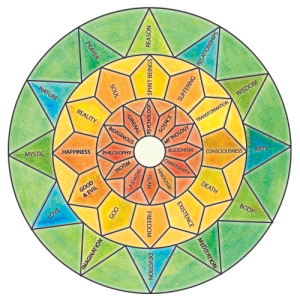
INTRODUCTION TO SPIRITUAL STYLES
Discovering, Honoring and Harnessing Your Styles for Learning & Practice
 The major religions have developed rituals, myths, deities, metaphysics, aesthetics, meditations, devotional prayers, etc., that match up to the natural archetypal styles residing in human beings everywhere. Implicitly, they have created big tents and found niches for everyone. However, as with educational institutions, religious and spiritual institutions often slip into a one-size-fits-all mode of spiritual education and practice. This is also true of meditative practices. Too often, teachers a single modality for all students. This often leaves many ‘out in the cold.’
The major religions have developed rituals, myths, deities, metaphysics, aesthetics, meditations, devotional prayers, etc., that match up to the natural archetypal styles residing in human beings everywhere. Implicitly, they have created big tents and found niches for everyone. However, as with educational institutions, religious and spiritual institutions often slip into a one-size-fits-all mode of spiritual education and practice. This is also true of meditative practices. Too often, teachers a single modality for all students. This often leaves many ‘out in the cold.’
Since each of us has all these archetypal styles nascent within us, these need to be honored, utilized and brought into harmony in order for each individual to be fully engaged on a spiritual path. Primary archetypal styles differ from one person to the next and often change in the course of a person’s lifetime. Unknowingly, they provide us with a starting point for spiritual belief and practice. Unconsciously, they lead us toward our spiritual paths, meditative practices and guide our journeys.
Therefore, it is important to begin by identifying our own natural spiritual archetypal styles. As we progress down the path, it will be important to begin integrating our other styles so that our understanding, action and experience form an integrated and solid foundation for our internal spiritual life and external engagement in the world. Transformation into our ideal (or ‘fully actualized’) human being has forever been a human quest. Therefore, we need bring all our archetypal styles in alignment around a single goal. Why? Because often there is an ‘internal argument’ between our styles that prevents us from wholeheartedly engaging in our transformation toward an ideal state of being.
The profiling tool will help you discover your archetypal spiritual styles and harness them to create your spiritual path and meditative practice. Your styles may shift over the course of your life. Therefore the present results of this instrument are informative but not fixed for all time. The results will simply help stimulate a greater inner awareness about how you learn and how you can harness your natural styles for learning and practicing. If you are a teacher or mentor, this instrument can help you to know your student better and to help them to gain greater self knowledge. In this way, you are not telling them what to believe and how to practice, but midwifing their personal discovery of a spiritual path and/or a contemplative practice.
The results of this profile are not definitive. Nor are they meant to pigeonhole or confine you to one or more spiritual styles. Rather, they are meant to awaken you to the archetypal styles deep within you that you might not have recognized or utilized. Once you awaken to the styles that your present lenses for learning, then you can harness them to help you find your spiritual answers and develop a practice of meditation that is right for you.
